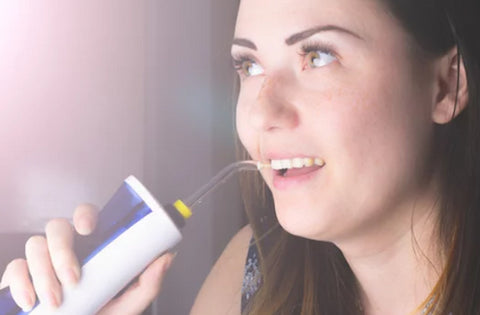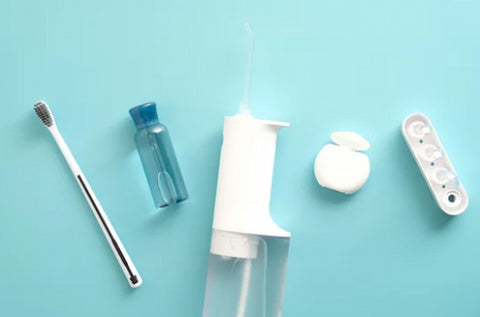Water flossing, also known as oral irrigation, is famous worldwide, including in America and Europe. With water flossing, you can clean your teeth and gums by removing plaque and debris with water pressure instead of traditional string floss or toothpicks. How does a water flosser work?
Key Takeaways
|
Did you know that even mild gum disease can lead to more severe health problems in the future? Here at Dr. Brite, we believe everyone deserves healthy teeth and gums. We have created our line of water flossers to help you take good care of your oral health without visiting the dentist whenever you need your teeth cleaned.
Get 15% Off with discount code (use at checkout): BLOG15
How Does a Water Flosser Work?
A water flosser is an oral irrigator that uses a stream of a pressurized, pulsating, or continuous flow of water to remove food particles and bacterial biofilm from the teeth. Water flossers can be used with toothbrushing for oral hygiene and often replace traditional floss. How often you water floss depends on your dental work, oral hygiene routine, and how often you see your dentist for professional cleanings.
This type of product is generally easier to use than traditional flossing because it is unnecessary to thread the cord through the mouth.

Some people find it more comfortable to use due to less physical effort. The most common water flossers are designed as attachments on either a countertop or portable bathroom sink faucet, known as a flossing sink. Other models are designed for travel and may run on batteries or solar power, have built-in pressure control, and features like a handle grip for easy portability.
Should You Consider A Water Flosser?
Water flossers have been clinically proven to be more effective than traditional dental floss. Your water flosser could even remove tonsil stones for that matter. Also, traditional floss can reach only couple of milimeters deep, but water floss can clean deeper to even diminish tartar, and remove tonsil stones for good.
Here are some benefits of using water flossers for your dental hygiene routine:
Healthy Gums
A study has shown that water flossing is almost as effective as our sonic toothbrush at reducing gingivitis and plaque, which can lead to gum disease and bad breath. It also helps prevent periodontal disease by removing the sticky film called biofilmfrom teeth and under the gum line that can harbor bacteria and lead to gums inflammation.
Gentle on Teeth and Mouth
Water flossers provide gentle care for sensitive teeth and gums, unlike traditional flossing. Traditional string or thread dental floss can damage your mouth, leaving it sore and inflamed. The gentle flow of water in water flossers reduces irritation while cleaning away plaque and food debris.
Prevents Bad Breath
Hydrogen sulfide is released when certain types of food decompose in the mouth, and water flossing significantly reduces levels of hydrogen sulfide. These sulfur-containing gases can produce halitosis when we eat cabbage, broccoli, cauliflower, onions, and garlic.
Easy to Use
All you need to do is fill the reservoirwith warm water, attach the nozzle (or pick one up off a counter), and start brushing. No waiting for a sink to get hot, no scrubbing your fingers raw trying to dislodge stubborn bits of food.
You should clean your water flosser after every use, as it helps prevent the buildup of plaque or bacteria in your unit. Also, for hygienic reasons if you consider sharing a water flosser with a member of your family or a close friend, there are precautions that allow users to share a water flosser safely.

Get 15% Off with discount code (use at checkout): BLOG15
Who Needs to Use a Water Flosser?
Water flossers are an easy way to maintain your oral health. They're accommodating people with the following dental work and issues:
-
Braces
-
Dental implants
-
Crowns and bridges
-
Early gum disease and gingivitis.
Water flossers help remove bacteria in hard-to-reach places that electric toothbrush alone or traditional flossing can't reach. Dr. Brite's dental water jet flossers have a patented pressure release system, which delivers the optimal amount of pressure needed to clean away plaque without damaging delicate gum tissue or irritating sensitive teeth and gums.
As mentioned above,this oral hygiene tool can clean tight crevices and eliminate debris, plaque, and bacteria from hard-to-reach sections of the mouth. Water flossers don't interfere with braces, dental bridges and similar dental work as they are abrasion-free.
Can a Water Flosser Cause Gum Recession?
No. Water flossers remove plaque from teeth and gums, leading to gum recession. If used correctly, water flossers will not cause gum recession. Here are some tips on the best way to use your new Waterpik properly:
-
Set your pressure setting low and gradually increase it until you find the right setting for you
-
Practice using your new device before using it with mouthwash or toothpaste
-
Fill the tank with warm or cool water (never hot)
-
Use gentle back-and-forth movements to clean all around your mouth. Be sure to get every nook and cranny
-
Rinse off any excess liquid in your mouth after cleaning.
-
Spit out any remaining juice after rinsing.
-
Finally, reinsert your lower jaw into its natural position while holding your tongue up against the roof of your mouth.
Factors to Consider When Buying a Water Floss
Before buying, it is essential to research the best brands, ingredients, and quality. For example, Dr. Brite has made it to the top of most lists due to its quality and beneficial components, such as eucalyptus extract and peppermint oil, that soothe gums and freshen their breath. It also features a two-speed system with an ultra-low-pressure setting for sensitive teeth and gums. Other factors include:
-
Water pressure - Higher water pressure provides deeper cleaning but might be too intense for some users or people with sharp teeth or gums.
-
Tongue scraper – A tongue scraper helps remove bacteria from the tongue and can improve bad breath. The tool comes in different shapes, sizes, and materials, including stainless steel and plastic
-
Flossing aids – Flossing aids are sometimes needed for those who have difficulty using traditional dental floss.
Get 15% Off with discount code (use at checkout): BLOG15
FAQs
When Should You Use a Water Flosser?
You should use it to floss teeth before and after meals, at least twice a day, and whenever necessary to remove plaque or food particles from the teeth and gum line
How Effective Is Water Flossing?
Water flossing is more effective than dental flossing in reducing plaque buildup, gum disease, and gingivitis (inflammation of the gums). It's also considered less abrasive on your gums than using a string floss method such as dental floss.
Is Water Flossing as Good as Dental Flossing?
Standard dental floss is proven to be more effective than traditional floss for removing plaque and other debris from the teeth and around the gums; however, studies show that water flossing isn't always an adequate substitute for dental floss when it comes to cleaning between teeth or for those who have received recent dental work.
How Often Should I Change My Tips?
Typically, every three months, with proper care and maintenance. Some customers say they can go up to six months before replacing them.
Got Any More Questions?
The combination of pulsating jets and high-pressure water cleans deep between teeth and below the gum line, where traditional floss and brushing can't reach. Give Dr. Brite's water flosser a try for thirty days, and see for yourself. Buy now from our website or your local drugstore. You can also email us at team@drbrite.com for more information on water flossing, dental work, or dental issues such as gum disease associated with your dental hygiene.













